Two weeks ago I received my GoPro Video camera in the mail and was very excited to see if it could help me videotape my swimming at the pool. I bought both the standard lens and wide angle lens as forums on the TI website had noted that both lenses may be useful depending on what I wanted to video. I also bought the suction cup assembly assuming that it would suction onto the side of a pool. The camera plus suction cup looks like this:
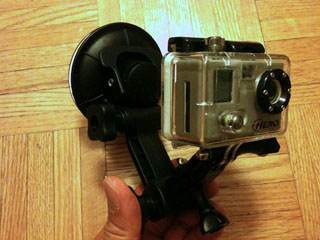
It’s nicely sealed in a watertight case which is waterproof to 100 feet.
Taking the camera to the pool, I found some constraints.
1. Depending on which pool you go to, they may have some rules regarding taking pictures or video because of privacy concerns. I go between two YMCAs and unfortunately they have strict rules on videoing. Thankfully, the lifeguards were pretty cool to let me take some video as long as I was alone in the lane.
2. The tile on the side of the pool may prohibit the suction cup sticking properly onto it. If the tiles are small, it could let air into the suction cup and thus, it won’t stick.
3. Lighting is critical. Since the camera’s sensor is pretty small, the more light the better. So on a sunny day, the video can capture me getting a lot farther down the pool before my body becomes undiscernable. See the comparison on the following two videos. This video was taken at an outdoor pool on a bright sunny day:
You can see my strokes for many times before I disappear into the distance.
This video, for comparison, was taken at an indoor pool with relatively poor lighting.
You can see how the water is much murkier looking in the second video. Unfortunately, I don’t get many strokes down the lane before I disappear so I can’t study my stroke for too many cycles which sucks.
By the way, I editted both videos and cut out the parts of the video where I disappear off into the distance and you can’t see me any more.
4. The video camera should be pointed down the middle of the lane and/or you should swim directly towards it versus off to a side. In the first video, I was able to find a place to stick the camera such that I could swim directly at it. It provides the best view of both sides of my body when stroking. In the second video, the pool side had small tiles, with the exception of where the lane number was and that tile was big enough to put the suction cup on. However, the big tile was offset to the middle of the lane and swimming towards it not directly meant I was losing some view of one side’s strokes.
5. By the way, being alone in the lane is pretty important. Otherwise, somebody else swimming there might inadvertantly knock your GoPro off the wall if they’re not careful. Certainly, you’ll capture a random person on video too.
Watching these videos, I was really able to study the problems in my stroke.
Here is what I learned:
1. Over the last few weeks, I drilled my left arm entry intensely to follow a wider track, since it felt like it was entering way too close to my head relative to my right arm. However, I did feel that my right arm was moving on a wider track. Looking at the video, I saw that my left arm had indeed began entering on a wider track:
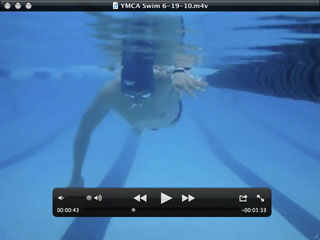
This was good and I was happy that my drilling produced the desired result. However, in studying my right side, which I had assumed was doing OK, I noticed that the entry occurred OVER my head.
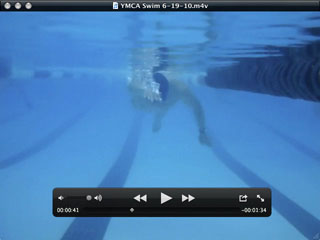
This was extremely weird and unexpected! At least my right arm ended up in the right place after entry, but it should not be entering into the water OVER my head but it should be further out like my left arm entry.
2. On both sides, upon the end of the spear of my arm forward, it then drops:
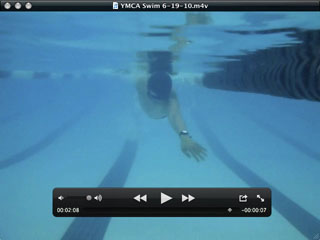
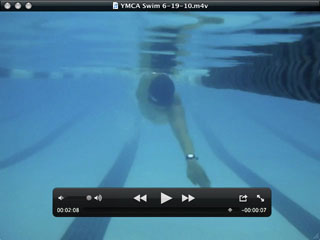
In studying swimming videos of Coach Shinji and also Dave Cameron, their speared arms never drop! I believe this robs me of some forward momentum as the deeper my arm is, the more water resistance there is (according to some literature I’ve read about the effect of the stroking arm’s depth).
3. When I swim, I use the two beat kick. On my left side with left arm stroking backward, I kick only with my left leg. Looking on the video, on my right side with right arm stroking backward, I sometimes do a scissor kick and kick with both legs! This can be seen somewhat in this screen grab, although if you watch the first video again, you will see it in motion:
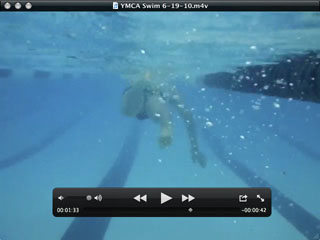
Here my right arm is stroking back and my right leg has kicked, but my left leg is cocked back and just about to kick. This is bad! My proper kicking leg is imparting rotational force to my body turn, which adds force to my stroke backward. However, if I kick my other leg while my body is turning, it resists the force of my body turn and making it weaker, thus making my stroke back also weaker. I believe this is why my left arm spear/right arm stroke back results in lesser forward momentum than my other side; I can see it when I swim where it results in me traveling further on one side but not the other!
I think this is a result of either or both of poor balance on that side and/or just my nervous system being programmed to kick twice for some reason on that side.
Absorbing all this, I jumped into the pool this last week and attempted to correct all of these. The first thing I noticed that was that my left arm spear/right arm stroke back resulted in more forward momentum, now that I focused on only kicking my right leg. Awesome!
Less successfully, I wasn’t able to move my right arm outward as much. I think this will require drilling more at slower stroke rates to fully correct. I seemed to be able to do this at lower stroke rates (I was using my tempo trainer here), but when I got to faster tempos it broke down pretty quickly and I could sense I was back to my old habit of entering OVER my head (so weird…!).
Video analysis is so enlightening and I am now bringing my GoPro always to the pool, in hopes that I can find some accomodating lifeguards who will let me video. I also want to test in another indoor pool which is lighted much better to see how the GoPro performs. I have not tried the wide angle version either, but fear that the distortion of the lens may make swimming analysis difficult. In the forums, someone noted that it was good for taking a longer view of swimming from the side, since the camera is stationary. I will have to try that to see if that is worthwhile. Otherwise, I will just use my wide angle GoPro for cool biking and running shots!
Monthly Archives: June 2010
Total Immersion: Retraining the Nervous System with Drills and Tempo Trainer
These last few weeks I’ve been really focused on retraining my nervous system. Why? Because I was working with Coach Shinji and feeling good about my swimming…until I started doing some detail comparisons of my swimming videos with those of Shinji and on the Easy Freestyle DVD.
UGH!
I had a major problem with what I call “hand lead recovery”. It should be elbow led, not hand led! At times it makes me look like I’m pawing at the water. I also saw that my left arm was clearly doing something different than my right arm. It’s entry was much closer to my head and I really needed to be swimming on wider tracks. I think this also affected my ability to use gravity to assist the hand/arm drop into the water as it spears forward. With a focus on noticing what was different, I swam a few laps and really discovered that my swimming was not symmetrical at all.
At this point, I had to do something about this before I ingrained bad habits. It was time to retrain my nervous system before I had to build for the Alcatraz 100 swim in October.
So I went back to basics. I pulled up Chapter 5 of the Easy Freestyle DVD and concentrated on drilling the elbow circle, ear hops, drawing straight lines front to back to front, and then used the Zen switch drill to practice all this. (To know what these mean, check out the excellent TI DVD, Easy Freestyle DVD).
I spent about a month drilling. My typical workout for this period netted out to about 1000-1200y on a 25y pool and looked like this:
200-400 warm up with typical TI drills:
2×25 Superman glide
2×25 R and L side one arm skate
2×25 R and L side one arm under switch
2×25 under switch swim continuous
2×25 R and L side one arm zen switch to pause, raise elbow to water surface
2×25 R and L side one arm zen switch to pause, raise hand to water surface
2×25 full stroke, one stroke only, start with R or L side, repeat
2×25 full stroke, two strokes only, start with R or L side, repeat
200y of zen switch continuous, or pause for rest every 50y, elbow at surface of water
200y of zen switch continuous, or pause for rest every 50y, middle of forearm at surface of water
200y of zen switch continuous, or pause for rest every 50y, wrist at surface of water
200y of zen switch continuous, or pause for rest every 50y, fingertips at surface of water
200y of zen switch continuous, or pause for rest every 50y, full stroke
for the last series of 200y sets, I would focus on elbow circling, drawing straight lines front/back, focus on the position of my left arm as it moved forward and then let gravity drop the arm down into the water and forward to spear.
Some observations:
1. It was interesting to note how different the feeling was between having the hand/arm touching the water versus above the water. The water served to anchor my brain’s perception of where my hand was. When it was out of the water, I immediately felt awkward; I had to train my brain to know where my left arm was in space, as it is moving during swimming! Over a period of a month, I slowly got better at this until I felt like I could, for the most part, repeatedly put my arm in the same place every time as it came forward.
2. With my head down, I would peek at where my arms would spear to. Consistently, my left arm would actually spear almost straight forward whereas my right arm would spear slightly outside, which is where I want it for wide track swimming. I discovered that I had to mentally spear what was perceived as “extra wide” and when I did that, my left arm would actually end up where I wanted it to be. I also realized that my front deltoid and pectoral muscle (specifically the pec minor as this is where my ART guy would constantly work out tightness there) had a twinge of tightness when I speared “extra wide”. I think that a lack of flexibility in my left arm in that area has caused my spear to end up more straight than wide.
3. Coach Shinji would always tell me that my left arm was being thrown more forward and I needed to enter the water closer to my ear. So I had to mentally bring back my entry point closer to my ear.
4. My spearing momentum was very weak and added little to my forward propulsion. This was especially apparent on my left arm, and even worse during when I took a breath when I would literally come to a stop in the water! So now as I enter, I would let gravity take my arm and drop it into the water so that it added momentum to the spear forward. I also had to practice this while taking a breath so that my momentum while turning to breathe would not disappear.
Slow swimming was key here. I got rid of the need to swim fast and just focused on form only. I would stroke slowly back versus with force and found that as my form improved, I was actually moving forward quite fast and smoothly even though I used little force. I definitely now could see what TI coaches were saying in that it is amazing to see how little force one needs to use to swim fluidly and with some speed.
My goal was to first retrain my nervous system using drills and slow swimming. Once my brain got better at telling where my left arm was in space, and I was hitting the “mail slot” on my left side better, as well as having significant improvement on elbow led recovery and not arm led, I started doing reps of 50y or 100y with the tempo trainer. Now I would proceed to retraining my nervous system to repeat the habits at higher speeds.
My strategy was to use the tempo trainer to slowly bring my new habits into ever faster repetitions, or faster arm cycle tempos. I used the tempo trainer in two ways:
1. I used it to determine where my nervous system was at, for a given workout day.
2. Then I would use it to inch my way to a faster tempo and then reinforce the habit at those faster tempos, usually at some tempo limit I had for that day where I could maintain the good form, and also up to the point at which I get tired and when my form starts to fall apart.
After my typical 200-400y warmup, I would then do 100s of Zen switch with arm rising higher each time until I hit full stroke swimming. Then I started using the tempo trainer. I determined that my slow swimming was about at a 1.6 sec tempo. At the first workout, I started just swimming at 1.6 sec tempo to get used to using the tempo trainer again, and syncing my swimming cycle to a beep.
The next workout I started determining at what tempo limit my newfound habits would fall apart. I would swim 100s at 1.6 sec tempo, then drop by .5 sec tempo until I found the fastest tempo where my form would start to fall apart while attempting to keep that tempo.
The first time I tried this, I got to 1.4 sec tempo where for each arm cycle it felt messy and awkward to maintain form. Then I just backed up .5 sec to 1.45 sec where it felt OK. I then proceeded to do what Terry Laughlin did, which was to do laps at .01 sec tempo faster each time until I hit 1.4 sec. Amazingly, if I approached my tempo limit by inching up to it, my nervous system was able to adapt and I could swim with decent form at what seemed to be the tempo at which my nervous system had a limit that day. After inching up to it, I would do a few more laps to reinforce the sensations and habits until I got tired and my form would start to falter again. At this point I would get out of the pool.
Week over week, I was able to get to faster tempos. The next time I started at 1.5 sec and repeated the same descend by .5 sec until I found my new limit (at 1.3 sec) and then backed up and inched towards it again and did some more repeats. The workout after that I started at 1.4 sec and made it to 1.2 seconds. At 1.2 seconds I seemed to need more time to reinforce my nervous system with good form, so I did that workout again.
Also, depending on my mood, how much time I had, and how my body felt, I would sometimes do laps of 50y instead of 100s due to those constraints. But no matter, I was still improving and progressing.
My next step is to do 2 things:
1. Continue form and nervous system training at faster tempos down to .8 sec.
2. Lengthening my laps from 50-100y to 200 and beyond, in preparation for the Alcatraz 100. This would also inevitably mean my total workout length would increase, and I hope to get to 3000-4000y in a workout as I get closer to race day.
Key learnings here are:
1. It takes time and patience to retrain the nervous system but it can be done. I had to give up on being paranoid about not having enough fitness for the Alcatraz 100 in order to find time to do this.
2. Detail analysis, focus and attention to subtle differences during video analysis really helped me figure out what I was doing poorly.
3. Singular focus on a training element helps reinforce that particular habit. But I also would keep in the back of my mind all the other things I should be doing as I focused. This also required practice but is really useful so that my form wouldn’t get messy in other places while I was focusing on one thing.
4. Using the tempo trainer to inch my way to faster tempos is an amazing technique for retraining my nervous system.
Grant Hackett and Ian Thrope Swimming Analysis
TI coach Dave Cameron posted this amazing series of photos analyzing the freestyle stroke of Grant Hackett and Ian Thrope.
Two things I wanted to point out which were very interesting to me:
First, in pictures 5 and 6, it’s unbelievable to see how high their elbows are on the catch. I tried this and it seemed kind of awkward, and I think ultimately I probably dropped my elbow much more than these swimmers did. I also didn’t feel the full advantage afforded by such a high elbow catch. I hope to work on this more as the beginning TI drills we tend to spear to a certain low position, versus spearing more horizontal and then catching from there, which tends to be something we work on after we get past the beginning drills.
Second, in 14, the text says that in a picture of Hackett that he presses his chest down while breathing. Breathing up to this point for me has always seemed to stop me dead during that moment. So I began trying to press the armpit/chest right at the moment of breathing and some interesting things happened:
1. At the moment of pressing, my head sank very fast and there was only a small moment when I could take my breath before water encircled my sideways facing mouth. This was in contrast to being simply turned and I had more time to take a breath.
2. When I consciously pressed at the breathing moment, my hips rode higher and my momentum was preserved much better, meaning that I still had forward movement versus coming to a stop during the breath.
I hope to see more of these analyses of top swimmers. It’s so instructive to see how they move through the water.